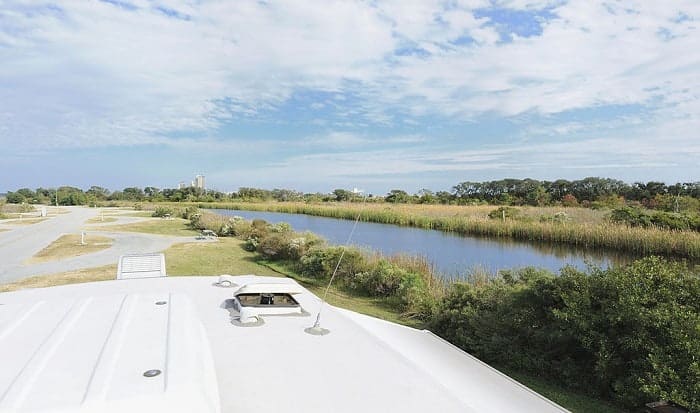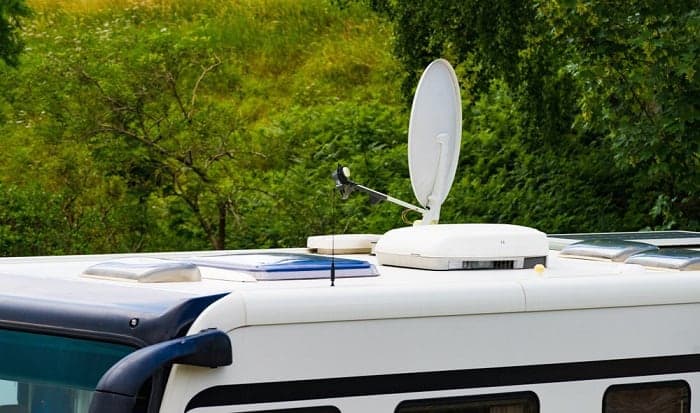RV roofing has it tough with various weather conditions when you are on the road. So, they wear out and require replacement. If you are confused about which material to use for replacing your RV roof, here is a TOP vs. Fiberglass RV roof comparison to help you make an informed decision.
Apart from the differences in the two materials, we have also highlighted how you can maintain your RV roof so that it would last long.
Table of Contents
TPO Roofing
TPO or Thermoplastic Polyolefin roofing material is a recent trend in the RV industry but has become quite popular in a short span and has replaced PVC roofing. The reason behind its popularity could be its affordable price and white color.
TPO is available in the form of a rubber membrane, obtained from any experienced manufacturer in the industry. They are large sheets so you can buy one that will fit the top of your RV perfectly and attach it to the top using industrial-grade adhesives or heavy-duty fasteners.
What Makes TPO a Popular Choice
It is a seamless and robust solution to roof your RV as TPO is resistant to mold formation, does not let dirt accumulate, and can handle the deepest impacts without puncturing.
When you travel through different climates, the roofs develop leakage due to thermal expansion and contraction. But guess what? TPO can be reinforced to handle these phenomenons.
Furthermore, the fact that the TPO is UV-resistant makes it perfect for you to head to a hotter destination for your trip. Its white color helps too. With TPO, your RV stays cooler as white color reflects heat and allows the RV to cool down faster. You can also experiment with your roof color with TPO since it is available in almost all shades.
TPO is also known for being energy resistant because it holds the heating and cooling in the TV for longer, saving you a lot of power in air conditioning and heating.
The installation costs with TPO are significantly less, for it is lightweight and mostly one sheet is required to cover the entire truck
Why Should You Consider Other Options
While the above advantages of TPO make it sound like the perfect roofing solution, there are a few downsides. For starters, TPO is a relatively young technology launched in the 1990s, and manufacturers are still working on how to make it more durable.
Manufacturers are experimenting on the material to find a solution for its durability, which might soon hit the market.
Another issue with TPO is that it is poor at handling a high thermal load. In layman’s terms, if you park your RV under the sun’s scorching heat for too long, the TPO roof can suffer excessive weathering. So, it is not meant for the folks in the Southern regions of the country.
It is better to ask the manufacturer about the amount of thermal load the material can handle. If it is anything less than 160 degrees, don’t opt for it and keep looking.
Fiberglass RV Roofing or GRD (Glass Reinforced Polyester) Flat Roof
Fiberglass is another material that can keep your motorhome running smoothly without any leakages whatsoever. Fiberglass is made up of glass fiber, which has been around for centuries. But it was the Prussian inventor Hermann Hammesfahr who patented its use in the US in 1880.
Later, it was Owens Corning, a manufacturing company in the US that patented the use of glass fiber for production of “fiberglas” (yes, with one “s”) in 1935. In its original form, fiberglass was a glass wool with fibers entrapping several gallons of gas in them so that it can be used as an insulator in extreme temperatures.
The reinforcement of several layers of glass fiber on top of each other forms a strong structure, both costlier and heavier than other rubber-based roof materials like EPDM and TPO. Then again, fiberglass beats rubber roofs in the test of durability, strength, and need for maintenance any day.
It would not be wrong to say that you can forget about your fiberglass roof shortly after installing because it doesn’t need frequent fixes and keeps your RV well insulated, ensuring heat in winters and cool air in summers. Plus, fiberglass expands and contracts according to the climate, allowing you to travel to different climate zones in the country without having to worry about wear and tear.
Similarities and Differences between TPO and Fiberglass Roofing
Cost
When planning to replace the RV roofing, you might want to check out the price first because there is a humongous difference between the two materials. While TPO is cheaper, between $5-$16 per square meter, fiberglass is expensive as it falls in the price bracket of $90-$115 per square meter.
If you are on a tight budget, you can stick to TPO or relax your budget 9-fold to be able to fit in some quality fiberglass for your RV’s roof!
Maintenance
We are overawed by how expensive the fiberglass because of the lack of maintenance it requires over the years. If you get the installation done right in the first go, you can forget about it for the next 30-50 years because repairs are a rare event in fiberglass roofing.
As for TPO, it can last for as long as 20 years if you are dedicated to it, always parking your RV in spots with low heat, and doing everything to maintain it. This video will help you with TPO maintenance.
Quality
In terms of quality, fiberglass surpasses TPO with its string built to deal with almost any weather condition. No amount of thermal loads can shatter the will of fiberglass to keep you sheltered in your RV, and proper installation of it will blow your worry about leaks away.
On the other hand, the quality of TPO depends on the manufacturing process. If you are an avid camper and love to visit far-off places, TPO might not serve as well in temperature resistance.
If we speak of similarities, both these materials provide excellent insulation to your RV, keeping it temperature-controlled even in the harshest of weather conditions. The performance of fiberglass is still better than that of TPO in this scenario as well.
Roof Maintenance Tips
As promised in the beginning, here are some roof maintenance tips that we have acquired from the RV experts.
1. RV Roof Coating
RV roof coating is an additional protective layer that you can add on to make your roof water-resistant and weatherproof. Make sure that you replace this coating every year as it can wear out early on an RV rubber roof and needs reapplication.
You can use the Heng’s Rubber Roof Coating or the one by Dicor Corporation.
2. RV Liquid Roof
If you want to add a nice sheen to your RV roofing and protect it from the sun’s UV rays, you can always give it an extra layer of protection with a liquid roof coating. It prolongs the life of the rubber roof and prevents any water damage.
3. Cleaning the RV Roof
Washing the RV roof every once in a while will save you from mold development, breeding insects due to water accumulation, and protecting it from dirt and debris, which can puncture. You can use a mild detergent to wash the top of your RV. There are rubber-safe RV Roof cleansers you might want to try.
4. RV Roof Covers
Covering your RV with a UV-resistant cover is a great idea as it will keep it protected from heat and rain at all times. This will save you from investing in an additional parking space for the RV when it is sitting idle.
Conclusion
To conclude, investing in a fiberglass roof might burn a hole in your pocket, but it will prove perfectly well for your RV if you tend to go camping almost every season. Plus, it will save you the money that is spent on buying maintenance equipment for your roofing.
Those of you whose current budget cannot afford fiberglass roofing can invest in maintaining the RV roof with the solutions mentioned above.
Proper maintenance will prolong the life of your rubber roofing, saving you money and offering functionality.

Hi, I am Tom Hank, an RV-er since 2014. Back then, I started without much help. As you can imagine, the struggles are endless. But now, you do not have to begin your adventures knowing next to nothing about RV lives.




